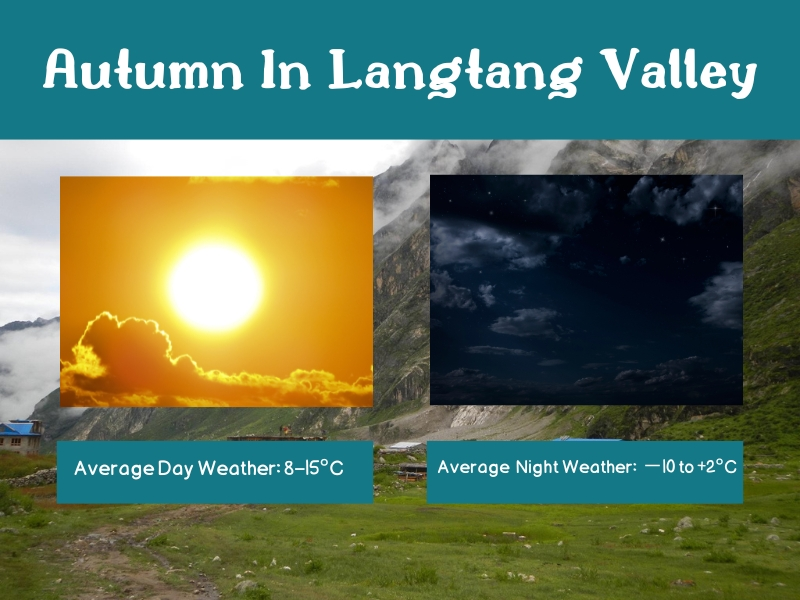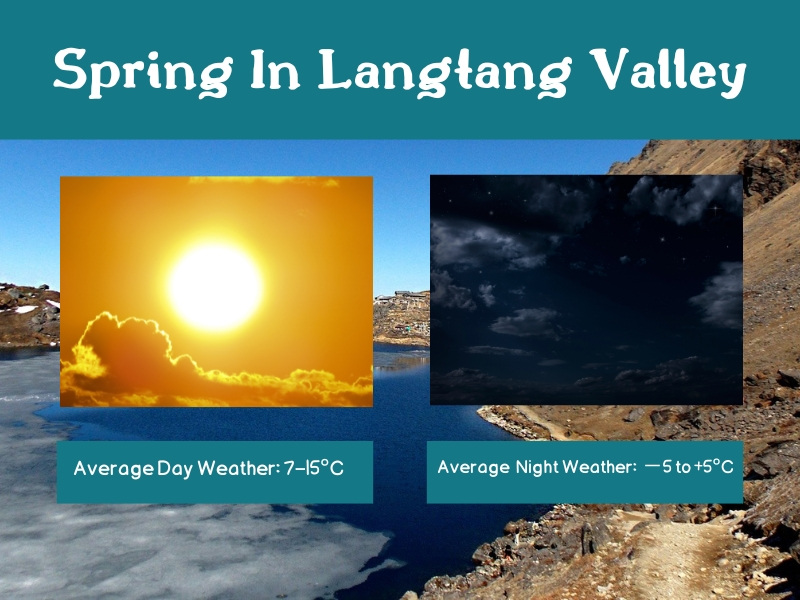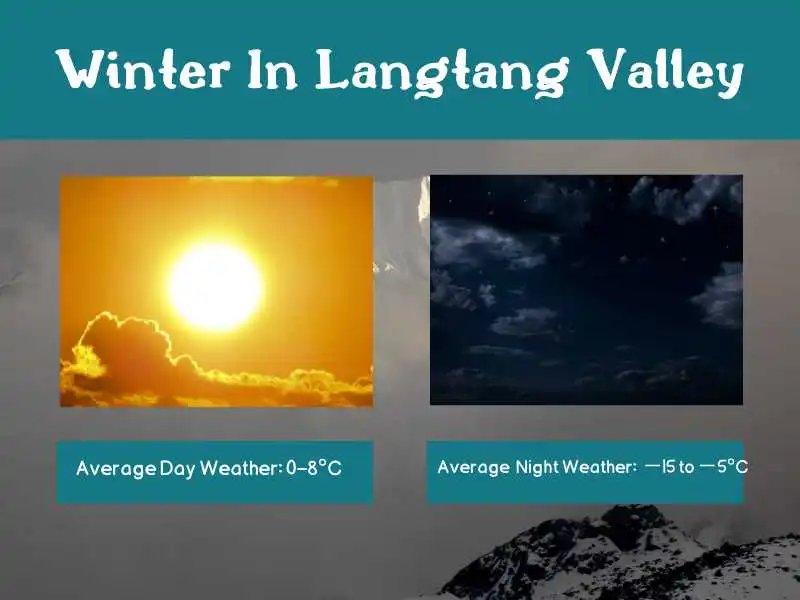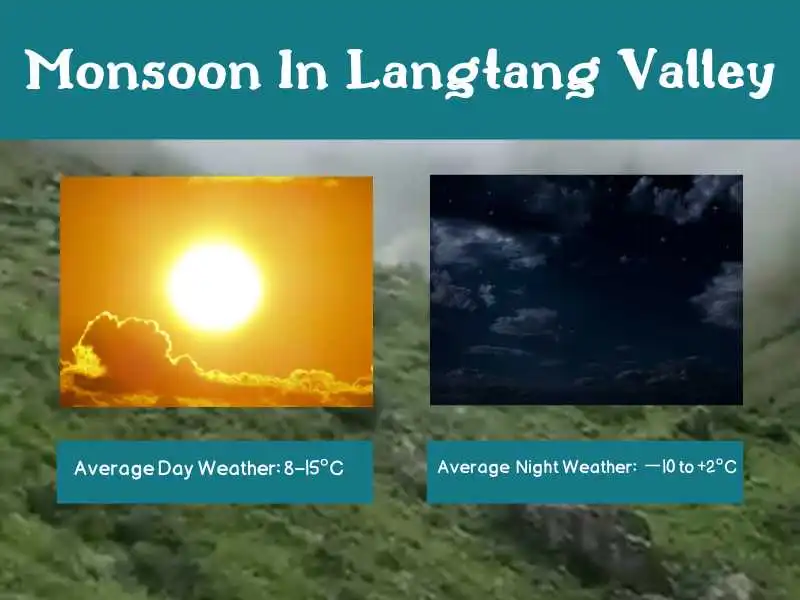Ever wondered what might be the best season to trek in Langtang Valley? Well, the short answer to your growing question is that it’s autumn (October-November). And the second Langtang Valley trek best season that closely follows is spring (March-May).
| Season | Best window | What you get | Watch-outs | Ideal for |
| Autumn | Mid-Oct to Mid-Nov | – Clear skies – stable weather – full lodge services – predictable summit mornings | Peak crowds, Dashain/Tihar travel rush, colder nights | First-timers, photographers, short itineraries |
| Spring | Late-Mar to Mid-Apr | – Mild temps – Long daylight – Rhododendron bloom – Comfortable walking | Haze/smoke some afternoons, wind on ridges;start early | Comfort seekers, flower lovers, early risers |
| Early Winter | Late-Nov to Dec | – Crystal morning views – Quiet trails – Great photo light | Sub-zero nights at Kyanjin, shorter days, occasional ice/snow | Solitude seekers, cold-ready trekkers |
| Monsoon | Jun To Aug | – Lush green valleys – Empty trails – Budget rooms | Frequent rain, leeches in forests, and road/landslide delays to Syabrubesi | Flexible, experienced hikers with buffer days |
One of the best things about Langtang Valley is that its trails are open all year round. However, your experience in each season is going to differ. All 4 seasons bring their weather patterns, scenery, and challenges in the Langtang valley. While the locals are well aware of what happens in each season, the international trekkers, on the other hand, are usually less familiar. During the spring and autumn, you will find comfortable walking conditions and a balanced experience. However, in winter and monsoon, due to harsh cold and slippery pathways, the trek becomes more challenging. So, in this guide, we will explore each season in detail. At first, we will talk about spring and autumn and tell you guys why those are the best seasons for the Langtang Valley Trek. We hope that after reading this blog, you will know exactly what to expect in each season.
But, if you wish to go on a culturally focused trek like the Tamang Heritage Trail Trek, then the best time differs as you need to plan your timing on the basis of local festivals.
Why is Autumn (October-November) the best season to trek in Langtang Valley?
Autumn in Nepal begins right after the heavy monsoon from June to August. This is the time when the air dries out, dust settles, and the visibility increases drastically. Furthermore, the trails from Syabrubesi right up to Kyanjin Gompa are usually firm. In fact, as per our guide, Pemba Tamang
Autumn mornings are a gift in Langtang, if you want to hike to Kyanjin Ri and Tserko Ri. The weather is very predictable, and the mountain opens up with views that never disappoint.”
Additionally, Autumn also gives you the generous daylight of more than half a day. This means even if you take multiple breaks, you will still reach your next destination before dusk. The other main factor behind the fall, being the peak season, is the festival window. Dashain and Tihar, the two biggest holidays of Nepal, are celebrated during this time. Due to this, trekkers from around the world would be able to grasp the culture of the region fully. As a matter of fact, if you look closely, this window also fits perfectly with Western holidays. Both Canada’s and the US’s Thanksgiving falls during the month of fall.

However, since it’s the prime time to visit the valley, you will notice some increase in the price of accommodation and food. In fact, if you didn’t book early, even the price of a ticket to Nepal might increase drastically. Our blog on Langtang Valley Trek Cost provides an in-depth analysis of the cost. Besides that, autumn also comes with colder nights in the upper valley. So, don’t forget to pack warm sleeping bags as well.
| Month | Daytime (°C) | Nighttime (°C) | Visibility & notes |
| September | 10–15 (Kyanjin) | −2 to 2 | Transition month; improving clarity mid-to-late month. |
| October | 10–18 | −10 to −1 | Prime clarity and stable weather; busiest weeks. |
| November | 2–10 (Kyanjin) | −12 to −8 | Very clear, colder nights; first snows possible on side peaks. |
Related: Langtang Valley Trek 5 Days Itinerary And Cost In 2025
Why spring is the second-best season To Go On the Langtang Valley Trek
While autumn might bring extra-crisp panoramas, spring comes with longer daytime light. The weather is usually warm during spring. Furthermore, during this time, the whole forest is naturally painted in red and pink. In fact, this window is best for those who are into floriculture. From late March to mid-April, the lower belts of Lama Hotel and Ghodatabela are at their best. The other factor that makes many trekkers interested in spring is the daytime weather and daylight. Even at night, compared to different seasons, the temperature is quite manageable.

Additionally, the Spring also lines up with many school breaks and public holidays in many countries. There is Easter in Canada and the UK, Memorial Day in the US, and ANZAC Day and King’s birthday in Australia. The coolest part is that there are actually no major holiday windows in Nepal so that the roads won’t be busy like in the Autumn. However, there are some things that you need ot consider in this season. The weather is warm and cool, but one can’t deny that it’s unpredictable. No one really knows when the rain will make the whole trail muddy and slippery. Besides that, while the visibility for trails might be excellent, the viewpoint might be affected due to the regional haze or smoke from other parts of Nepal. So, if nature is your priority, spring is wonderful. But if you want the long-range view of mountains like Langtang Lirung and complete risk-free trails, then it mightn’t be your first choice.
| Month | Daytime (°C) | Nighttime (°C) | Visibility & notes |
| March | 5–12 | −8 to −2 | Clear/cool mornings; haze can begin late month; lower valley ~10–15 °C days. |
| April | 2–12 (Kyanjin) | −10 to −5 | Bloom at lower/mid belts; best views early; rising pre-monsoon haze risk. |
| May | 10–18 (upper valley) | 5–8 | Warmest spring month; long days; occasional pre-monsoon showers. |
What Winter Really Feels Like On This Trek?
Winter in Langtang trades crowds for calm, and it swaps soft evenings for crisp, crystal mornings that make the mountains look impossibly close. Days are shorter (around 10 to 10 1⁄2 hours of daylight in December, stretching to about 11½ hours by late February), so your walking rhythm naturally shifts to earlier starts and shorter stages between Syabrubesi, Lama Hotel, Langtang Village, and Kyanjin Gompa. Temperatures feel honest at altitude: mornings bite, the shade stays cold, and nights at Kyanjin often slip well below freezing, especially after a clear sunset. Trails are usually dry and stable, but ice lingers on stone steps, north-facing slopes, and the last push to viewpoints after fresh snow.

Because of that, winter gear is simple but specific: a real insulating layer, warm hat and gloves, and microspikes for the week after snowfall so the final 200-300 meters to Kyanjin Ri or Tserko Ri feel secure. Teahouses remain open in the main villages, but some smaller places reduce capacity for a few weeks in deep winter, so it’s wise to check ahead before committing to a tight plan. If you love quiet trails, starry skies, and the kind of air that makes every ridge stand out, winter is deeply rewarding, as long as you respect the cold and keep your ascent steady once you pass the high-3,000s. Expert note – Pemba Tamang:
In winter we start at first light and we keep the stages short on icy days. I tell my guests to drink hot fluids at every stop, keep hands warm, and enjoy the calm air at sunrise-that’s when Langtang shows its true face. If a storm dusts the ridge, we shift the plan, wait for the sun to soften the ice, and then go for the viewpoint.
| Month | Daytime (°C) | Nighttime (°C) | Visibility & notes |
| December | 0–5 (Kyanjin) | −15 to −10 | Crisp, very clear air; short days; ice after storms. |
| January | 0–5 | −15 to −10 | Coldest stretch; frequent hard frosts; very clear mornings. |
| February | 5–10 | −10 to −5 | Gradual warm-up; lingering ice in shade. |
Is Monsoon Worth It If You Are Flexible?
Monsoon (June to early September) paints the valley a deep, living green, quiets the lodges, and gives you those dramatic breaks when the cloud lifts and the light hits the flanks of Langtang Lirung like a spotlight. But it also asks for patience: frequent rain, leeches in the lower forest belts, and slick stone steps are normal, and the big variable sits before you even step on the trail—the Pasang Lhamu Highway to Syabrubesi. In very wet spells, that road can move to one-way control, slow to a crawl while crews clear debris, or close after a landslide; July is historically the riskiest month, and we all remember the July 2025 flood that broke the border bridge at Rasuwagadhi and disrupted traffic for days.

If monsoon is your only window, build 1–2 buffer days on both ends of the trek and keep your itinerary forgiving so you can wait out a closure without stress. Your daily tactic is simple: start early, aim to be off the ridge by early afternoon, and accept that the best views often arrive right after a shower, not at noon. Footwear with wet-traction soles, trekking poles, leech socks or long gaiters, and proper waterproofing for your essentials turn a wet week into a workable, even beautiful adventure. If you want low prices, quiet trails, and don’t mind a bit of mud to earn your peace, the monsoon can still be memorable—especially in the late-August to early-September transition when the pattern begins to relax.
| Month | Daytime (°C) | Nighttime (°C) | Visibility & notes |
| June | 10–18 (upper valley) | 5–10 | Cloudy/foggy spells common; trails muddy; views open after rain. |
| July | 10–18 | 5–10 | Lowest visibility; heavy rain; road/landslide disruptions likely. |
| August | 10–18 | 5–10 | Gradual improvement late month; leeches below ~2,500 m. |
Other things to Consider Before Choosing the season?
- Permits and rules stay the same all year: you need a Langtang National Park entry permit and a TIMS card issued via a registered trekking agency, and you must trek with a licensed guide under Nepal’s current policy.
- Road reliability changes with rain: the Pasang Lhamu Highway can be delayed or closed in July–August; a buffer day on each side is cheap insurance if you travel in or near the monsoon.
- Daylight quietly shapes every plan: as a rule of thumb, think about 11h40m in October, about 10h25m in December, about 12h50m in April, and about 13h50m in June; earlier starts mean better light, safer footing, and calmer winds.
- Acclimatization first, always: once you sleep above 3,000 m, keep sleeping-altitude gains modest, add a light or rest day at Kyanjin before big viewpoints, and tell your guide early if symptoms show.
- Insurance that actually works: carry travel insurance with helicopter evacuation coverage for trekking altitudes and keep the policy numbers handy; weather can ground flights in both monsoon and winter.
- Connectivity is better but still patchy: Nepal Telecom 4G reached the Langtang–Kyanjin corridor in May 2025, which helps a lot near Kyanjin; forests and side valleys still drop signal, so bring offline maps and a power bank.
- Photography & haze reality: late-Mar to Apr can be hazy some years; planning pre-dawn starts puts you on the viewpoint before the air softens.
- Wildlife & ethics: the fir–bamboo belts (approximately 2,800–3,900 m) are red-panda habitat; sightings are rare, so keep distance, don’t go off-trail, and avoid food baiting.
- Teahouse truths: expect paid charging and paid Wi-Fi in the upper valley, cash-only in many lodges, and simpler menus in winter; carry a filter or tablets for water all year.
- Packing changes by season: autumn = sun + cold layers; spring = early starts + dust/haze control; monsoon = rain shell + leech plan; winter = insulation + microspikes after storms.
FAQ About The Best Season Of Langtang Valley Trek
1) What is the single best month for the Langtang Valley Trek?
October—because skies are usually the clearest, trails are dry and stable, and daylight is long enough to move calmly between villages.
2) Is April as good as October?
Almost, but different: April feels warmer and longer, with forests in bloom, while October still wins for ultra-crisp, long-range views day after day.
3) Can I trek in December or January?
Yes, if you like quiet trails and clear mornings, and you bring proper cold-weather gear, keep stages shorter and carry microspikes for icy steps after fresh snow.
4) Is monsoon trekking realistic?
It is. if you’re flexible, start early, and hold 1–2 buffer days for the Syabrubesi road; expect leeches in forests and limited long-range views many afternoons.
5) Do I still need a guide and TIMS in 2025/26?
Yes, guide + TIMS are required in Langtang year-round, and going with a licensed guide also helps with route choices in the shoulder and winter seasons.
6) How many days of daylight do I really have to work with?
Roughly around 11h40m in mid-October, around 10h25m in mid-December, around 12h50m in mid-April, and around 13h50m in late June; this is why early starts pay off in every season.
7) When are the trails least crowded but still reliable?
Late November to early December and mid–late March are sweet spots—clear mornings, manageable cold, and fewer people than mid-October or peak April.
8) Will I get phone signal and Wi-Fi on the Langtang Valley Trek?
It’s better than before, thanks to NTC 4G near Kyanjin, but forests and side valleys still drop out; expect paid Wi-Fi in some lodges and carry offline maps.
9) Which holidays should I plan around for easier bookings?
Inside Nepal, Dashain/Tihar makes late September–October busy; internationally, watch Easter, Memorial Day and Thanksgiving (US), Thanksgiving (Canada), and ANZAC/King’s Birthday/Labour Day (Australia), which cluster travel into spring and autumn.
10) What’s the safest way to handle altitude on this trek?
Keep sleeping-altitude gains are modest once you pass ~3,000 m, add a light or rest day at Kyanjin, hydrate well, and talk to a clinician about acetazolamide if your plan is tight; if symptoms rise, slow down or descend.

